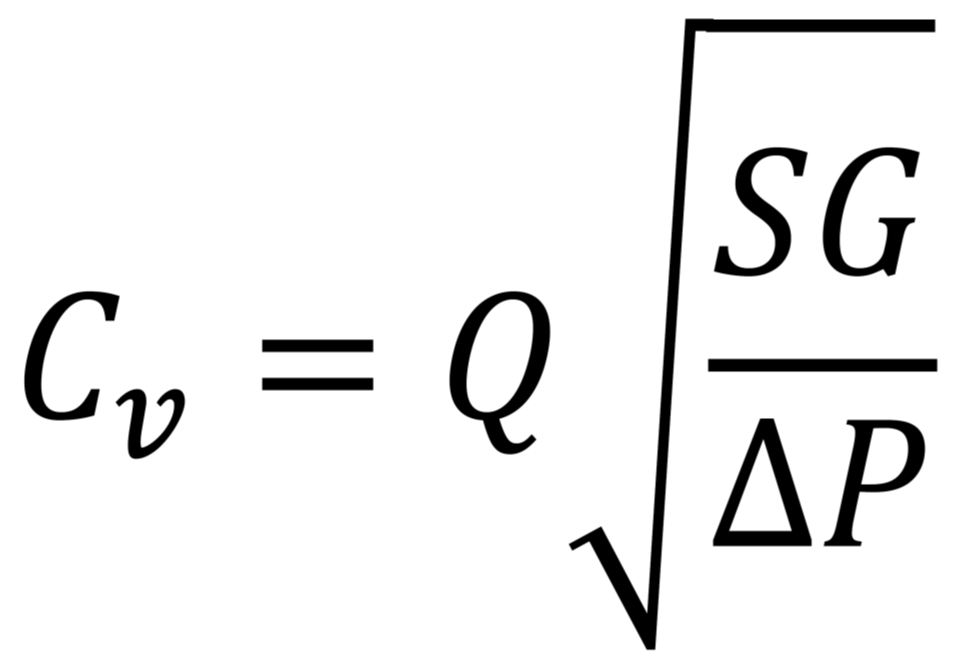May 19, 2021
Valves are available in many different styles, sizes, materials and connections. Choosing the right valve is primarily dependant on the task (control or on/off), the service conditions, the fluid (liquid, gas, combustible, corrosive etc..), and the load characteristics of your application. Below are a few suggestions and thoughts to keep in mind when selecting your valve:
1. Valve size:
The right valve choice means matching the valve's size to the expected flow through the system. The valve flow coefficient (Cv), or valve characteristic, is used to select the proper valve size while maintaining stable flow. The simple equation to calculate Cv is:

Q = Flow rate
SG = Specific gravity of fluid
∆P = Pressure drop across valve
A common mistake is calculating too high of a Cv by using the maximum flow rate, which results in selection of an oversized valve. The range of flow (min, max and mean flow rates) should be utilized to properly size the valve. However keep in mind that it is important to choose a valve with a Cv value sufficiently larger than the calculated Cv to help provide expected flow performance.
We have made calculating your CV value easier with our valve calculator. The calculator will also show you the most compatible electric actuator options based on your calculated CV.
2. Valve types:
Below are some common valve types and their general usage, as well as a short description of their distinct advantages & disadvantages:
| Valve Type | Usage | Advantages | Disadvantages |
|
Ball Valves |
Normally limited to strictly an "on–off" control function (fully open or fully closed positions).
Compatible with Hanbay quarter turn electric actuators. |
Reliable, cost-effective, require little maintenance, diverse (available in a wide range of materials and sizes), full unrestricted flow. | Limited throttling characteristics, difficult to clean which can lead to contamination. |
|
Needle Valves |
Used in flow-metering applications, to precisely and consistently control a low flow rate (modulating)
Compatible with Hanbay multi–turn electric actuators. |
High degree of precision and control, flexibility, resistant to both hot and cold temperatures, able to endure constant high pressure and vibrations. | Pressure loss is high, can only be used for low flow rates, seat and needle could get damaged if not operated carefully. |
|
Globe Valves |
Used for regulating flow or pressures as well as complete shutoff flow.
Compatible with Hanbay multi–turn electric actuators. |
Good shutoff capability, shorter stroke (compared to gate valves), can be used in high-pressure systems. | High pressure drop (head loss), unidirectional, opening speed is slower, not suitable for clean or sterile applications. |
|
Gate Valves |
Used in the fully open or fully closed positions. Not normally used to regulate flow because the flow rate of the fluid is not proportional to the amount that the valve is open.
Compatible with Hanbay quarter turn electric actuators. |
Small fluid resistance, energy efficient, unobstructed flow (does not decrease pressure), bidirectional. | Slow acting, bulky, not drip tight shut off, do not partially open as this will cause damage to seat/disc, low pressure limitations. |
|
Butterfly Valves |
Used for regulating flow and in the full open and fully closed position. They perform well in large volume water and slurry applications.
Compatible with Hanbay multi–turn electric actuators. |
Easy and fast to open, lightweight & reduced space requirements, lower maintenance. | Flow adjustment range is small, not suitable for high temperature or high pressure piping systems, and sealing performance is poor compared to ball valves and globe valves. |
|
Plug Valves |
On-off control, similar to ball valves.
Compatible with Hanbay quarter turn electric actuators. |
Long service life, high reliability, and ease of operation. | Higher initial cost than ball valves, and no throttling capabilities. |
3. Chemical and Environmental Compatibility:
Corrosion Resistance: The valve material needs to be compatible with the gases or liquids flowing through it. Hostile chemical environments will cause unsuitable valve materials to deteriorate due to chemical reactions.
Pressure: Consider the pressure ranges where the valve will be installed. Strength in a valve is it's ability to withstand the internal stresses generated by containing and controlling the fluid under pressure.
Temperature: Operating temperature is important to consider when choosing the right valve material for your application. When temperature is raised, a valves material strength will change, usually becoming softer and losing it's strength.
Environment and Maintenance: What type of environment your valve will be installed in and what this means for the maintenance of the valve. Harsh environments include extreme cold/heat, saline, moisture, acidic/alkaline etc...
Matching your valve with an electric actuator: Multi-turn and quarter turn valve actuators explained here. If you are not sure which valve actuator is the right fit for your application, don't hesitate to contact one of our engineers who would be happy to help you with your requirements.